Motorola SL7550 User Manual 2

PROFESSIONAL DIGITAL TWO-WAY RADIO
MOTOTRBO™ SL7550 PORTABLE USER GUIDE

Declaration of Conformity
This declaration is applicable to your radio only if your radio is labeled with the FCC logo shown below.
DECLARATION OF CONFORMITY
Per FCC CFR 47 Part 2 Section 2.1077(a)
Responsible Party
Name: Motorola Solutions, Inc.
Address: 1303 East Algonquin Road, Schaumburg, IL 60196, U.S.A. Phone Number: 1-800-927-2744
Hereby declares that the product: Model Name: SL 7550
conforms to the following regulations:
FCC Part 15, subpart B, section 15.107(a), 15.107(d) and section 15.109(a)
Class B Digital Device
As a personal computer peripheral, this device complies with Part 15 of the FCC Rules. Operation is subject to the following two conditions:
1.This device may not cause harmful interference, and
2.This device must accept any interference received, including interference that may cause undesired operation.
Conformity of Declaration
i
English

Declaration of Conformity
ii
Note: This equipment has been tested and found to comply with the limits for a Class B digital device, pursuant to part 15 of the FCC Rules. These limits are designed to provide reasonable protection against harmful interference in a residential installation. This equipment generates, uses and can radiate radio frequency energy and, if not installed and used in accordance with the instructions, may cause harmful interference to radio communications. However, there is no guarantee that interference will not occur in a particular installation.
If this equipment does cause harmful interference to radio or television reception, which can be determined by turning the equipment off and on, the user is encouraged to try to correct the interference by one or more of the following measures:
•Reorient or relocate the receiving antenna.
•Increase the separation between the equipment and receiver.
•Connect the equipment into an outlet on a circuit different from that to which the receiver is connected.
•Consult the dealer or an experienced radio/TV technician for help.
English

Contents
This User Guide contains all the information you need to use the MOTOTRBO SL7550 Portable Radios.
Important Safety Information . . . . . . . . . . . . . . . . . vi
Product Safety and RF Exposure Compliance . . .vi
Firmware Version . . . . . . . . . . . . . . . . . . . . . . . . . . . vi
Computer Software Copyrights . . . . . . . . . . . . . . . vii
Open Source Software Legal Notices . . . . . . . . . vii
Handling Precautions . . . . . . . . . . . . . . . . . . . . . . viii
RF Energy Exposure and Product Safety Guidelines and Instructions . . . . . . . . . . . . . . . . . . . . . . . . . . . viii
Operating Precautions . . . . . . . . . . . . . . . . . . . . . . . ix
Getting Started . . . . . . . . . . . . . . . . . . . . . . . . . . . . . . 1
How to Use This Guide . . . . . . . . . . . . . . . . . . . . . . . 1 What Your Dealer/System Administrator
Can Tell You . . . . . . . . . . . . . . . . . . . . . . . . . . . . . . 1
Preparing Your Radio for Use . . . . . . . . . . . . . . . . . . 2
Attaching the Battery . . . . . . . . . . . . . . . . . . . . . . . . . 2 Charging the Battery . . . . . . . . . . . . . . . . . . . . . . . . . 3 Attaching the Earpiece/Audio Accessory . . . . . . . . . 4 Powering Up the Radio . . . . . . . . . . . . . . . . . . . . . . . 4
Adjusting the Volume . . . . . . . . . . . . . . . . . . . . . . . . 5
Identifying Radio Controls . . . . . . . . . . . . . . . . . . . . 6
Radio Controls . . . . . . . . . . . . . . . . . . . . . . . . . . . . . 6 Programmable Buttons . . . . . . . . . . . . . . . . . . . . . . . 7 Assignable Radio Functions . . . . . . . . . . . . . . . . . 8 Assignable Settings or Utility Functions . . . . . . . . . 9 Using the 4-Way Navigation Disc . . . . . . . . . . . . . . . 9 Accessing the Programmed Functions . . . . . . . . . 10 Using the Keypad . . . . . . . . . . . . . . . . . . . . . . . . . . 11 Push-To-Talk (PTT) Button . . . . . . . . . . . . . . . . . . . 12 Capacity Plus . . . . . . . . . . . . . . . . . . . . . . . . . . . . . 13
Identifying Status Indicators . . . . . . . . . . . . . . . . . . 14
Display Icons . . . . . . . . . . . . . . . . . . . . . . . . . . . . . . 14 Call Icons . . . . . . . . . . . . . . . . . . . . . . . . . . . . . . . . 16 Utilities Icons . . . . . . . . . . . . . . . . . . . . . . . . . . . . . . 16 Mini Notice Icons . . . . . . . . . . . . . . . . . . . . . . . . . . . 17 Sent Item Icons . . . . . . . . . . . . . . . . . . . . . . . . . . . . 17 Job Tickets Icons . . . . . . . . . . . . . . . . . . . . . . . . . . 18 LED Indicator . . . . . . . . . . . . . . . . . . . . . . . . . . . . . 18 Audio Tones . . . . . . . . . . . . . . . . . . . . . . . . . . . . . . 19 Indicator Tones . . . . . . . . . . . . . . . . . . . . . . . . . . . . 20
Making and Receiving Calls . . . . . . . . . . . . . . . . . . 21
Selecting a Zone . . . . . . . . . . . . . . . . . . . . . . . . . . . 21 Selecting a Channel . . . . . . . . . . . . . . . . . . . . . . . . 22
Contents
i
English

Contents
ii
Receiving and Responding to a Radio Call . . . . . . 23 Receiving and Responding to a Group Call . . . . 23 Receiving and Responding to a Private Call . . . . 24 Receiving an All Call . . . . . . . . . . . . . . . . . . . . . . 24 Making a Radio Call . . . . . . . . . . . . . . . . . . . . . . . . 25 Making a Group Call with the PTT Button . . . . 26 Making a Private Call with the PTT Button . . . 26 Making an All Call . . . . . . . . . . . . . . . . . . . . . . 27 Making a Group or Private Call with the One Touch Access Button . . . . . . . . . . . . . . . . . . . . . . . . . . . 28
Making a Group, Private or All Call with the Programmable Number Key . . . . . . . . . . . . . . . . 28
Stopping a Radio Call . . . . . . . . . . . . . . . . . . . . . . . 30 Talkaround . . . . . . . . . . . . . . . . . . . . . . . . . . . . . . . 30 Monitoring Features . . . . . . . . . . . . . . . . . . . . . . . . 31 Monitoring a Channel . . . . . . . . . . . . . . . . . . . . . 31 Sticky Monitor . . . . . . . . . . . . . . . . . . . . . . . . . . . 32
Advanced Features . . . . . . . . . . . . . . . . . . . . . . . . . 33
Radio Check . . . . . . . . . . . . . . . . . . . . . . . . . . . . . . 33 Sending a Radio Check . . . . . . . . . . . . . . . . . . . 33 Remote Monitor . . . . . . . . . . . . . . . . . . . . . . . . . . . 35 Initiating Remote Monitor . . . . . . . . . . . . . . . . . . 35 Scan Lists . . . . . . . . . . . . . . . . . . . . . . . . . . . . . . . . 36 Viewing an Entry in the Scan List . . . . . . . . . . . . 36 Viewing an Entry in the Scan List by Alias Search 36
Editing the Scan List . . . . . . . . . . . . . . . . . . . . . . 37 Adding a New Entry to the Scan List . . . . . . . . 37 Deleting an Entry from the Scan List . . . . . . . . 37 Setting and Editing Priority for an Entry in the Scan List . . . . . . . . . . . . . . . . . . . . . . . . . . . . . 38
Scan . . . . . . . . . . . . . . . . . . . . . . . . . . . . . . . . . . . . 39 Setting an Active Scan List . . . . . . . . . . . . . . . . . 39 Starting and Stopping Scan . . . . . . . . . . . . . . . . 40 Responding to a Transmission During a Scan . . 40 Deleting a Nuisance Channel . . . . . . . . . . . . . . . 40 Restoring a Nuisance Channel . . . . . . . . . . . . . . 41
Contacts Settings . . . . . . . . . . . . . . . . . . . . . . . . . . 41 Making a Group Call from Contacts . . . . . . . . . . 42 Making a Private Call from Contacts . . . . . . . . . . 42 Making a Call by Alias Search . . . . . . . . . . . . . . 43 Assigning an Entry to a Programmable
Number Key . . . . . . . . . . . . . . . . . . . . . . . . . . . . 44 Removing the Association between Entry and Programmable Number Key . . . . . . . . . . . . . . . . 45 Adding a New Contact . . . . . . . . . . . . . . . . . . . . 45 Sending a Message to a Contact . . . . . . . . . . . . 46
Call Indicator Settings . . . . . . . . . . . . . . . . . . . . . . 46 Activating and Deactivating Call Ringers for
Call Alert . . . . . . . . . . . . . . . . . . . . . . . . . . . . . . . 46 Activating and Deactivating Call Ringers for
English

Private Calls . . . . . . . . . . . . . . . . . . . . . . . . . . . . . |
47 |
Activating and Deactivating Call Ringers for |
|
Text Message . . . . . . . . . . . . . . . . . . . . . . . . . . . |
47 |
Assigning Ring Styles . . . . . . . . . . . . . . . . . . . . . |
48 |
Ring Alert Type Selection . . . . . . . . . . . . . . . . . . |
48 |
Escalating Alarm Tone Volume . . . . . . . . . . . . . . |
49 |
Call Log Features . . . . . . . . . . . . . . . . . . . . . . . . . . |
49 |
Viewing Recent Calls . . . . . . . . . . . . . . . . . . . . . . |
49 |
Missed Calls . . . . . . . . . . . . . . . . . . . . . . . . . . . . |
50 |
Storing an Alias or ID from a Call List . . . . . . . . . |
50 |
Deleting a Call from a Call List . . . . . . . . . . . . . . |
50 |
Viewing Details from a Call List . . . . . . . . . . . . . . |
51 |
Call Alert Operation . . . . . . . . . . . . . . . . . . . . . . . . . |
51 |
Receiving and Responding to a Call Alert . . . . . . |
51 |
Making a Call Alert from the Contacts List . . . . . . |
52 |
Making a Call Alert with the One Touch Access |
|
Button . . . . . . . . . . . . . . . . . . . . . . . . . . . . . . . . . |
52 |
Emergency Operation . . . . . . . . . . . . . . . . . . . . . . . |
53 |
Receiving an Emergency Alarm . . . . . . . . . . . . . |
53 |
Responding to an Emergency Alarm . . . . . . . . . . |
54 |
Sending an Emergency Alarm . . . . . . . . . . . . . . . |
54 |
Sending an Emergency Alarm with Call . . . . . . . |
55 |
Sending an Emergency Alarm with Voice to |
|
Follow . . . . . . . . . . . . . . . . . . . . . . . . . . . . . . . . . |
56 |
Reinitiating an Emergency Mode . . . . . . . . . . . . . |
57 |
Exiting Emergency Mode . . . . . . . . . . . . . . . . . . . 57 Text Message Features . . . . . . . . . . . . . . . . . . . . . 58 Writing and Sending a Text Message . . . . . . . . . 58 Sending a Quick Text Message . . . . . . . . . . . . . . 59
Sending a Quick Text Message with the One Touch Access Button . . . . . . . . . . . . . . . . . . . . . . 59 Accessing the Drafts Folder . . . . . . . . . . . . . . . . . 60
Viewing a Saved Text Message . . . . . . . . . . . . 60 Editing and Sending a Saved Text Message . . 60 Deleting a Saved Text Message from Drafts . . 61 Managing Fail-to-Send Text Messages . . . . . . . . 61 Resending a Text Message . . . . . . . . . . . . . . . 62 Forwarding a Text Message . . . . . . . . . . . . . . . 62 Editing a Text Message . . . . . . . . . . . . . . . . . . 62 Managing Sent Text Messages . . . . . . . . . . . . . . 63 Viewing a Sent Text Message . . . . . . . . . . . . . 63 Sending a Sent Text Message . . . . . . . . . . . . . 63
Deleting All Sent Text Messages from
Sent Items . . . . . . . . . . . . . . . . . . . . . . . . . . . . 65 Receiving a Text Message . . . . . . . . . . . . . . . . . 65 Reading a Text Message . . . . . . . . . . . . . . . . . . . 65 Managing Received Text Messages . . . . . . . . . . 65 Viewing a Text Message from the Inbox . . . . . 66 Replying to a Text Message from the Inbox . . . 66 Deleting a Text Message from the Inbox . . . . . 67 Deleting All Text Messages from the Inbox . . . 67
Contents
iii
English

Contents
iv
Job Tickets . . . . . . . . . . . . . . . . . . . . . . . . . . . . . . . 68 Accessing the Job Ticket Folder . . . . . . . . . . . 68 Responding to the Job Ticket . . . . . . . . . . . . . 68 Deleting a Job Ticket . . . . . . . . . . . . . . . . . . . . . 69 Privacy . . . . . . . . . . . . . . . . . . . . . . . . . . . . . . . . . . 70 Covert Mode . . . . . . . . . . . . . . . . . . . . . . . . . . . . . . 71 Entering Covert Mode . . . . . . . . . . . . . . . . . . . . . 71 Exiting Covert Mode . . . . . . . . . . . . . . . . . . . . . . 71 Dual Tone Multi Frequency (DTMF) . . . . . . . . . . . . 71 IP Site Connect . . . . . . . . . . . . . . . . . . . . . . . . . . . 72 Locking Automatic Site Search . . . . . . . . . . . . . . 72 Unlocking Automatic Site Search . . . . . . . . . . . . 73 Starting a Manual Site Search . . . . . . . . . . . . . . 73 Security . . . . . . . . . . . . . . . . . . . . . . . . . . . . . . . . . 74 Radio Disable . . . . . . . . . . . . . . . . . . . . . . . . . . . 74 Radio Enable . . . . . . . . . . . . . . . . . . . . . . . . . . . 75 Lone Worker . . . . . . . . . . . . . . . . . . . . . . . . . . . . . . 76 Password Lock Features . . . . . . . . . . . . . . . . . . . . 77 Accessing the Radio from Password . . . . . . . . . 77 Unlocking the Radio from Locked State . . . . . . . 77 Turning the Password Lock On or Off . . . . . . . . . 78 Changing the Password . . . . . . . . . . . . . . . . . . . 78 Bluetooth Operation . . . . . . . . . . . . . . . . . . . . . . . . 79 Turning Bluetooth On and Off . . . . . . . . . . . . . . . 80 Finding and Connecting to a Bluetooth Device . . 80
Disconnecting from a Bluetooth Device . . . . . . . 81 Switching Audio Route . . . . . . . . . . . . . . . . . . . . 81 Viewing Device Details . . . . . . . . . . . . . . . . . . . . 81 Editing Device Name . . . . . . . . . . . . . . . . . . . . . 82 Notification List . . . . . . . . . . . . . . . . . . . . . . . . . . . . 82 Accessing the Notification List . . . . . . . . . . . . . . 82 Utilities . . . . . . . . . . . . . . . . . . . . . . . . . . . . . . . . . . 83 Turning the Radio Tones/Alerts On or Off . . . . . 83 Turning Keypad Tones On or Off . . . . . . . . . . . . 83 Setting the Tone Alert Volume Offset Level . . . . 84 Turning the Talk Permit Tone On or Off . . . . . . . 84 Changing the Display Mode . . . . . . . . . . . . . . . . 85 Adjusting the Display Brightness . . . . . . . . . . . . 85 Controlling the Display Backlight . . . . . . . . . . . . 86 Wallpaper Mode . . . . . . . . . . . . . . . . . . . . . . . . . 86 Screen Saver Mode . . . . . . . . . . . . . . . . . . . . . . 86 Audio Accessory . . . . . . . . . . . . . . . . . . . . . . . . . 87 Locking and Unlocking the Keypad . . . . . . . . . . 87 Auto Keypad Lock . . . . . . . . . . . . . . . . . . . . . . . 88 Language . . . . . . . . . . . . . . . . . . . . . . . . . . . . . . 88 Turning the LED Indicator On or Off . . . . . . . . . . 88
Turning the Voice Operating Transmission (VOX) Feature On or Off . . . . . . . . . . . . . . . . . . . . . . . . 89 Turning the Option Board Feature(s) On or Off . 90 Identifying Cable Type . . . . . . . . . . . . . . . . . . . . 90
English

Voice Announcement . . . . . . . . . . . . . . . . . . . . . . 90
Menu Timer . . . . . . . . . . . . . . . . . . . . . . . . . . . . . 91
Digital Mic AGC . . . . . . . . . . . . . . . . . . . . . . . . . . 91
Intelligent Audio . . . . . . . . . . . . . . . . . . . . . . . . . . 91
Accessing General Radio Information . . . . . . . . . 92
Accessing the Battery Information . . . . . . . . . . 92
Checking the Radio Alias and ID . . . . . . . . . . . 93
Checking the Firmware Version and Codeplug
Version . . . . . . . . . . . . . . . . . . . . . . . . . . . . . . . 93
Checking the Open-Source Software
Information . . . . . . . . . . . . . . . . . . . . . . . . . . . . 93
Batteries and Chargers Warranty . . . . . . . . . . . . . . 95
Limited Warranty . . . . . . . . . . . . . . . . . . . . . . . . . . . 96
Contents
v
English

Important Safety Information
Product Safety and RF Exposure Compliance
Before using this product, read the operating instructions for safe usage contained in the Product Safety and RF Exposure booklet
C a u t i o n enclosed with your radio.
Information |
ATTENTION! |
|
|
||
|
This radio is restricted to occupational use only to |
|
|
satisfy FCC/ICNIRP RF energy exposure |
|
Safety |
requirements. Before using this product, read the RF |
|
energy awareness information and operating instructions |
||
|
||
|
in the Product Safety and RF Exposure booklet enclosed |
|
|
with your radio (Motorola Publication part number |
|
Important |
6881095C98) to ensure compliance with RF energy |
|
exposure limits. |
||
For a list of Motorola-approved antennas, batteries, and |
||
other accessories, visit the following website: |
||
http://www.motorolasolutions.com/governmentandenterprise |
||
|
Any modification to this device, not expressly authorized by |
|
vi |
Motorola, may void the user’s authority to operate this device. |
Under Industry Canada regulations, this radio transmitter may only operate using an antenna of a type and maximum (or lesser) gain approved for the transmitter by Industry Canada. To reduce potential radio interference to other users, the antenna type and its gain should be so chosen that the equivalent isotropically radiated power (e.i.r.p.) is not more than that necessary for successful communication
Firmware Version
All the features described in the following sections are supported by the radio's firmware version R02.02.00 or later.
See Checking the Firmware Version and Codeplug Version on page 93 to determine your radio's firmware version.
Check with your dealer or system administrator for more details of all the features supported.
English

Computer Software Copyrights
The Motorola products described in this manual may include copyrighted Motorola computer programs stored in semiconductor memories or other media. Laws in the United States and other countries preserve for Motorola certain exclusive rights for copyrighted computer programs including, but not limited to, the exclusive right to copy or reproduce in any form the copyrighted computer program. Accordingly, any copyrighted Motorola computer programs contained in the Motorola products described in this manual may not be copied, reproduced, modified, reverse-engineered, or distributed in any manner without the express written permission of Motorola. Furthermore, the purchase of Motorola products shall not be deemed to grant either directly or by implication, estoppel, or otherwise, any license under the copyrights, patents or patent applications of Motorola, except for the normal non-exclusive license to use that arises by operation of law in the sale of a product.
The AMBE+2TM voice coding Technology embodied in this product is protected by intellectual property rights including patent rights, copyrights and trade secrets of Digital Voice Systems, Inc.
This voice coding Technology is licensed solely for use |
|
|
within this Communications Equipment. The user of this |
|
|
Technology is explicitly prohibited from attempting to |
Computer |
|
decompile, reverse engineer, or disassemble the Object |
||
|
||
Code, or in any other way convert the Object Code into a |
|
|
human-readable form. |
|
|
U.S. Pat. Nos. #5,870,405, #5,826,222, #5,754,974, |
|
|
#5,701,390, #5,715,365, #5,649,050, #5,630,011, |
Software |
|
#5,581,656, #5,517,511, #5,491,772, #5,247,579, |
||
|
||
#5,226,084 and #5,195,166. |
|
|
Open Source Software Legal Notices |
Copyrights |
|
This Motorola Product contains Open Source Software. |
||
For information regarding licenses, acknowledgements, |
||
required copyright notices, and other usage terms, refer |
||
to the Documentation for this Motorola Product at: |
||
http://www.motorola.com/businessonline |
vii
English
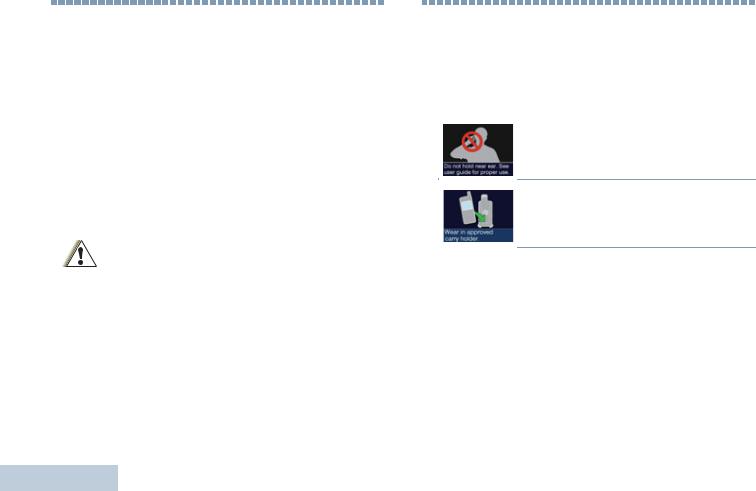
Handling Precautions
The MOTOTRBO Series Digital Portable radio meets IP54 specifications. Your radio limits protection against dust and water exposure.
• |
Keep your radio clean and exposure to water should be |
|
|
avoided to help ensure proper functionality and performance. |
|
• |
To clean the exterior surfaces of the radio, use a diluted |
|
|
solution of mild dishwashing detergent and fresh water (i.e. |
|
|
one teaspoon of detergent to one gallon of water). |
|
• |
These surfaces should be cleaned whenever a periodic visual |
|
PrecautionsHandling |
inspection reveals the presence of smudges, grease, and/or |
|
grime. |
||
|
The effects on certain chemicals and their vapors can have harmful results on certain plastics. Avoid using aerosol sprays, tuner
C a u t i o n |
cleaners and other chemicals. |
|
viii
RF Energy Exposure and Product
Safety Guidelines and Instructions
See more detailed proper usage instructions, warnings and cautions in the Regulatory Compliance and Product Safety Guide.
1To ensure a comfortable audio level and compliance with RF energy exposure limits, do not hold against the ear or alongside the head.
2Use only in front of the face or with Motorola Solutions approved audio accessories and carry cases to ensure compliance with RF energy exposure limits.
English

Operating Precautions
•Transmit no more than the rated duty factor of 50% of the time. To transmit (talk), push the Push-To-Talk (PTT) button. To receive calls, release the PTT button. Transmitting 50% of the time, or less, is important because this radio generates measurable RF energy exposure only when transmitting (in terms of measuring for standards compliance).
•To protect your hearing, use the lowest volume necessary to do your job, turn down the volume before adding a headset or earpiece, and limit the amount of time you use headsets or earpieces at high volume.
•User awareness instructions should accompany device when transferred to other users.
NOTE: For more details please read the information about RF Energy Exposure Awareness and Control Information and Operational Instructions for Occupational Use in the Quick Reference Guide/Safety Booklet (Motorola Publications number 68009553001) provided with your radio.
Precautions Operating
ix
English

Notes
Notes
x
English

Getting Started
Take a moment to review the following:
How to Use This Guide . . . . . . . . . . . . . . . . . . . . . . . . . page 1
What Your Dealer/System Administrator
Can Tell You. . . . . . . . . . . . . . . . . . . . . . . . . . . . . . . . page 1
 How to Use This Guide
How to Use This Guide
This User Guide covers the basic operation of the MOTOTRBO SL7550Digital Portable Radios.
However, your dealer or system administrator may have customized your radio for your specific needs. Check with your dealer or system administrator for more information.
Selected features are also available on this single-site trunking mode, Capacity Plus. See Capacity Plus on page 13.
 What Your Dealer/System Administrator
What Your Dealer/System Administrator
Can Tell You
You can consult your dealer or system administrator about the following:
•Is your radio programmed with any preset conventional channels?
•Which buttons have been programmed to access other features?
•What optional accessories may suit your needs?
•What are the best radio usage practices for effective communication?
•What maintenance procedures will help promote longer radio life?
Started Getting
1
English
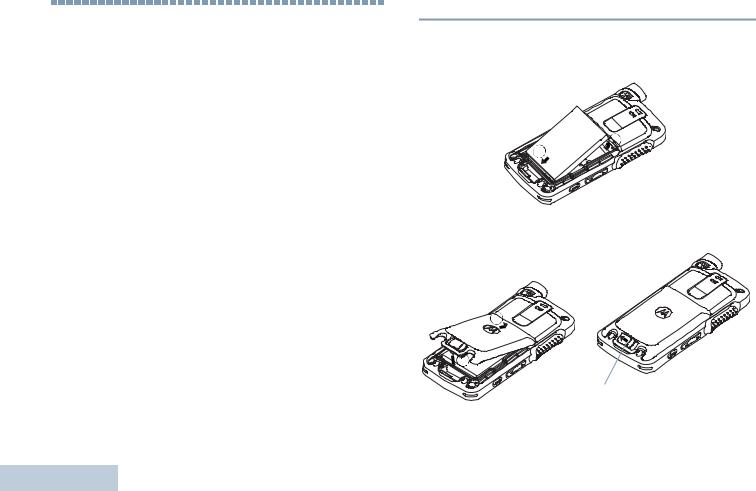
Preparing Your Radio for Use
2
Preparing Your Radio for Use
Assemble your radio by following these steps:
Attaching the Battery. . . . . . . . . . . . . . . . . . . . . . . . . . . page 2 Charging the Battery . . . . . . . . . . . . . . . . . . . . . . . . . . . page 3 Attaching the Earpiece/Audio Accessory . . . . . . . . . . . page 4 Powering Up the Radio . . . . . . . . . . . . . . . . . . . . . . . . . page 4 Adjusting the Volume . . . . . . . . . . . . . . . . . . . . . . . . . . page 5
 Attaching the Battery
Attaching the Battery
Align the battery contacts with the contacts inside the battery compartment. Insert the contact side of the battery first. Gently push the battery into place.
2
1
To attach battery cover, align it in place and slide the battery latch until it snaps into place. Slide battery latch into lock position.
1
2
Battery
Latch
English
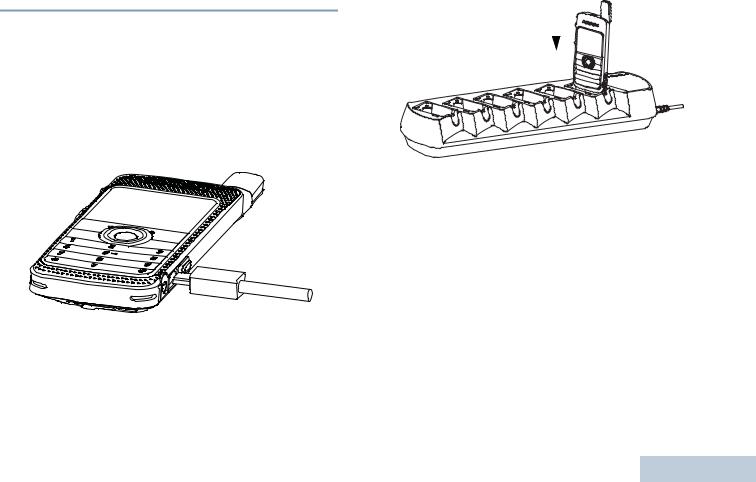
 Charging the Battery
Charging the Battery
Your radio is powered by a Lithium-Ion (Li-lon) battery. To avoid damage and comply with warranty terms, charge the battery using a Motorola charger exactly as described in the charger user guide. All chargers can charge only the Motorola authorized batteries. Other batteries may not charge.
Charge a new battery 14 to 16 hours before initial use for best performance. Prior to charging a battery with the radio, it is recommended to turn the radio off. Batteries charge best at room temperature.
NOTE: The battery charging icon will be displayed until the user unplugs the USB cable or takes the radio out of the charger.
Use for Radio Your Preparing
3
English
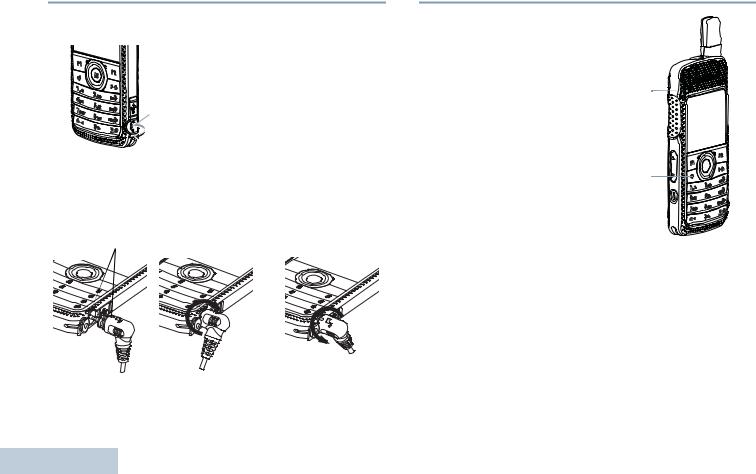
Preparing Your Radio for Use
4
 Attaching the Earpiece/Audio Accessory
Attaching the Earpiece/Audio Accessory
The audio jack is located on the antenna side of the radio. It is used to connect MOTOTRBOSL7550 accessories to the radio.
Lift up the flap of the Audio Jack cover.Align the indicators on both the connector and housing, then push until it fits in properly.
Audio Jack
Rotate connector clockwise or counterclockwise to lock.
To unlock, rotate until the indicators on both the connector and housing are aligned. Pull out the connector gently to disconnect from radio.
Indicators
OR
 Powering Up the Radio
Powering Up the Radio
Press the On/Off button on the front keypad. You see
MOTOTRBO (TM) on the radio’s display momentarily, followed by a welcome message or welcome image.
The LED lights up solid green and the Home screen lights up. The backlight depends on the last brightness setting.
LED
Indicator
On/Off
Button
English
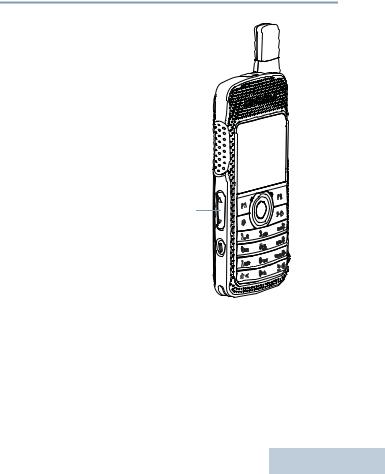
NOTE: Brightness is set via the manual brightness mode or auto brightness is controlled by the radio’s photo sensor. The Home screen does not light up during a power up if the LED indicator is disabled (see Turning the LED Indicator On or Off on page 88).
A brief tone sounds, indicating that the power up test is successful.
NOTE: There is no power up tone if the radio tones/alerts function is disabled (see Turning the Radio Tones/ Alerts On or Off on page 83).
If your radio does not power up, check your battery. Make sure that it is charged and properly attached. If your radio still does not power up, contact your dealer.
To turn off the radio, press the On/Off button again and hold for 2 seconds. You see a brief Powering Down on the radio’s display.
 Adjusting the Volume
Adjusting the Volume
To increase the volume, push the Volume Button up.
To decrease the volume, push the Volume Button down.
NOTE: Your radio can be |
|
programmed to |
|
have a minimum |
|
volume offset |
|
where the volume |
|
level cannot be |
Volume |
lowered past the |
Button |
programmed |
|
minimum volume. |
|
Check with your |
|
dealer or system |
|
administrator for |
|
more information. |
|
Use for Radio Your Preparing
5
English
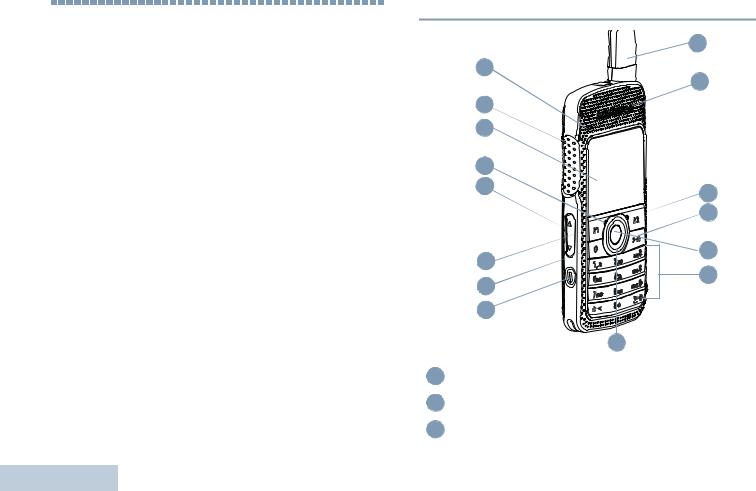
Identifying Radio Controls
6
Identifying Radio Controls
Take a moment to review the following:
Radio Controls . . . . . . . . . . . . . . . . . . . . . . . . . . . . . . . page 6 Programmable Buttons . . . . . . . . . . . . . . . . . . . . . . . . . page 7 Using the 4-Way Navigation Disc . . . . . . . . . . . . . . . . . page 9 Accessing the Programmed Functions . . . . . . . . . . . . page 10 Using the Keypad . . . . . . . . . . . . . . . . . . . . . . . . . . . . page 11 Push-To-Talk (PTT) Button . . . . . . . . . . . . . . . . . . . . . page 12 Capacity Plus . . . . . . . . . . . . . . . . . . . . . . . . . . . . . . . page 13

 Radio Controls
Radio Controls
10
1
11
2 |
|
|
3 |
|
|
4 |
|
|
5 |
12 |
|
|
||
|
13 |
|
6 |
14 |
|
15 |
||
7 |
||
|
||
8 |
|
|
|
9 |
1LED Indicator
2Push-to-Talk (PTT) Button
3Display
English

4Microphone
5Volume Button
6Front Button P1*
SP: _____________ LP: _____________
7On/Off Button
8Emergency Button*
94-way Navigation Disc
10Antenna
11Speaker
12Front Button P2 *
SP: _____________ LP: _____________
13Back/Home Button
14Menu/OK Button
15Keypad
* These buttons are programmable.
 Programmable Buttons
Programmable Buttons
Your dealer can program the programmable buttons as |
Identifying |
|
|
duration (between 1.00 second and 3.75 seconds). |
|
shortcuts to radio functions or preset channels/groups |
|
|
depending on the duration of a button press: |
|
|
• |
Short press – Pressing and releasing rapidly (0.05 seconds). |
|
• |
Long press – Pressing and holding for the programmed |
|
• |
Hold down – Keeping the button pressed. |
Radio |
NOTE: The programmed duration of a button press is |
||
|
applicable for all assignable radio/utility functions or |
|
|
settings. See Emergency Operation on page 53 for |
Controls |
more information on the programmed duration of the
Emergency button.
For your convenience, a programmable button can also be customized to support up to 9 of your favorite features. Please consult your dealer for programming options.
7
English

Identifying Radio Controls
8
Assignable Radio Functions
Actions – A programmable button to access a CPS programmable action list.
Audio Routing – Toggles audio routing between internal radio speaker and external accessory speakers.
Power Battery Indicator – Displays the current status of the battery level.
Bluetooth® Audio Switch – Toggles audio routing between internal radio speaker and external Bluetooth-enabled accessory.
Contacts – Provides direct access to the contacts list.
Call Alert – Direct access to the radio contacts list to select a radio contact to send a call alert to.
Call Log – Selects the call log list.
Channel Announcement – Plays zone and channel announcement voice messages for the current channel.
Display Radio Alias - Shows radio display name.
Emergency – Depending on the programming, initiates or cancels an emergency alarm or call.
Intelligent Audio On/Off – Toggles intelligent audio on or off. Job Tickets – Allows the user to view and act upon job tickets.
Manual Dial for Private Call – Allows the user to dial a private call manually.
Manual Site Roam* – Starts the manual site search.
Mic AGC On/Off – Toggles the internal microphone automatic gain control (AGC) on or off.
Monitor – Monitors a selected channel for activity. Notifications – Provides direct access to the Notifications list.
Nuisance Channel Delete* – Temporarily removes an unwanted channel, except for the Selected Channel, from the scan list. The Selected Channel refers to the user’s selected zone/channel combination from which scan is initiated.
One Touch Access – Directly initiates a predefined Private or Group Call, a Call Alert or a Quick Text message.
Option Board Feature – Toggles option board feature(s) on or off for option board-enabled channels.
Permanent Monitor* – Monitors a selected channel for all radio traffic until function is disabled.
Privacy – Toggles privacy on or off.
Radio Alias and ID – Provides radio alias and ID.
Radio Check – Determines if a radio is active in a system. Radio Enable – Allows a target radio to be remotely enabled. Radio Disable – Allows a target radio to be remotely disabled.
Remote Monitor – Turns on the microphone of a target radio without it giving any indicators.
Repeater/Talkaround* – Toggles between using a repeater and communicating directly with another radio.
* Not applicable in Capacity Plus
English

Ring Alert Type – Provides direct access to the Ring Alert Type Setting.
Scan – Toggles scan on or off.
Site Lock On/Off* – Toggles the automatic site roam on or off. Text Message – Selects the text message menu.
Transmit Interrupt Remote Dekey – Stops the transmission of a remote monitored radio without giving any indicators, or an ongoing interruptible call to free the channel.
Unassigned – Unassigned programmable button.
Voice Announcement On/Off – Toggles voice announcement on or off.
Voice Operating Transmission (VOX) – Toggles VOX on or off.
Zone – Allows selection from a list of zones.
Assignable Settings or Utility Functions
All Tones/Alerts – Toggles all tones and alerts on or off.
Brightness – Allows brightness to be set via the manual brightness mode or auto brightness control via the radio’s photo sensor.
Display Mode – Toggles the day/night display mode on or off. Keypad Lock – Toggles keypad between locked and unlocked. Wallpaper – Displayed on home screen.
* Not applicable in Capacity Plus

 Using the 4-Way Navigation Disc
Using the 4-Way Navigation Disc
You can use the 4-way navigation disc, e, to scroll through |
Identifying |
||||
options, increase/decrease values, and navigate vertically. |
|||||
|
|||||
|
Direction |
|
|||
|
|
||||
|
|
|
|
|
|
Category |
^ or v |
< or > |
|
||
|
|
|
|
Radio |
|
Menu |
Vertical Navigation |
– |
|||
|
|
|
|
||
Lists |
Vertical Navigation |
– |
|||
|
|||||
|
|
|
|
|
|
View Details |
Vertical Navigation |
Previous/Next Item |
|
||
|
|
|
|
Controls |
|
Numeric Values |
Increase/Decrease |
– |
|||
|
|
|
|
||
The > button can be used to change the channels in the home |
|||||
You can use the 4-way navigation disc, e, as a number, alias, or free form text editor.
screen.
9
English

Press the Menu/OK button to select your desired channel.
|
|
Direction |
||
|
|
|
|
|
Editor Category |
^ or v |
|
< or > |
|
|
|
|
|
|
Number |
– |
|
Left: Delete last digit |
|
|
Right: – |
|||
|
|
|
||
Alias |
– |
|
Move cursor one |
|
|
character left/right. |
|||
|
|
|
||
Free Form Text |
Move cursor up/down. |
Move cursor one |
||
character left/right. |
||||
|
|
|
||
Identifying Radio Controls
10
 Accessing the Programmed Functions
Accessing the Programmed Functions
You can access various radio functions through one of the following ways:
•A short or long press of the relevant programmable buttons.
OR
• Use the 4-way navigation disc as follows:
1To access the menu, press the c button. Press ^or v to access the required menu function.
2Press cto select a function or enter a sub-menu.
3To go back one menu level, or to return to the previous screen, press the dbutton. Long press the dbutton to return to the Home screen.
NOTE: Your radio automatically exits the menu after a period of inactivity and returns to your Home screen.
English

 Using the Keypad
Using the Keypad
You can use the alphanumeric keypad to access your radio’s features. You can use the keypad to enter subscriber aliases or IDs, and text messages. Many characters require that you press a key multiple times. The table below shows the number of times a key needs to be pressed to generate the required character.
|
|
|
|
|
Number of Times Key is Pressed |
|
|
|
|
|
|||
|
|
|
|
|
|
|
|
|
|
|
|
|
|
Key |
1 |
2 |
3 |
4 |
5 |
6 |
7 |
8 |
9 |
10 |
11 |
12 |
13 |
|
|
|
|
|
|
|
|
|
|
|
|
|
|
1 |
1 |
. |
, |
? |
! |
@ |
& |
‘ |
% |
- |
: |
* |
# |
2 |
A |
B |
C |
2 |
|
|
|
|
|
|
|
|
|
3 |
D |
E |
F |
3 |
|
|
|
|
|
|
|
|
|
4 |
G |
H |
I |
4 |
|
|
|
|
|
|
|
|
|
5 |
J |
K |
L |
5 |
|
|
|
|
|
|
|
|
|
6 |
M |
N |
O |
6 |
|
|
|
|
|
|
|
|
|
7 |
P |
Q |
R |
S |
7 |
|
|
|
|
|
|
|
|
8 |
T |
U |
V |
8 |
|
|
|
|
|
|
|
|
|
9 |
W |
X |
Y |
Z |
9 |
|
|
|
|
|
|
|
|
0 |
0 |
NOTE: Press to enter "0" and long press to activate the CAPS lock. Another long press to turn off the CAPS lock. |
|
||||||||||
* |
* or del |
NOTE: Press during text entry to delete the character. Press during numeric entry to enter a "*". |
|
|
|
||||||||
# |
# or space |
NOTE: Press during text entry to insert a space. Press during numeric entry to enter a "#". |
|
|
|
||||||||
Controls Radio Identifying
11
English

Identifying Radio Controls
12
 Push-To-Talk (PTT) Button
Push-To-Talk (PTT) Button
The PTT button on the side of the radio serves two basic purposes:
PTT
Button
•While a call is in progress, the PTT button allows the radio to transmit to other radios in the call.
Press and hold down PTT button to talk. Release the PTT button to listen.
The microphone is activated when the PTT button is pressed.
•While a call is not in progress, the PTT button is used to make a new call (see Making a Radio Call on page 25).
If the Talk Permit Tone (see Turning the Talk Permit Tone On or Off on page 84) is enabled, wait until the short alert tone ends before talking .
During a call, if the Channel Free Indication feature is enabled on your radio (programmed by your dealer), you will hear a short alert tone the moment the target radio (the radio that is receiving your call) releases the PTT button, indicating the channel is free for you to respond.
You will also hear a continuous talk prohibit tone, if your call is interrupted, indicating that you should release the PTT button, for example when the radio receives an Emergency Call.
English

 Capacity Plus
Capacity Plus
Capacity Plus is a single-site trunking configuration of the MOTOTRBO radio system, which uses a pool of channels to support hundreds of users and up to 254 Groups. This feature allows your radio to efficiently utilize the available number of programmed channels while in Repeater Mode.
When Capacity Plus is enabled, features not applicable to Capacity Plus are not available in the menu. Also, you hear a negative indicator tone if you try to access a feature not applicable to Capacity Plus via a programmable button press.
Your radio also has features that are available in both conventional digital mode and Capacity Plus. However, the minor differences in the way each feature works does NOT affect the performance of your radio.
Check with your dealer or system administrator for more information on this system configuration.
Controls Radio Identifying
13
English

Identifying Status Indicators
14
Identifying Status Indicators
Your radio indicates its operational status through the following: Display Icons. . . . . . . . . . . . . . . . . . . . . . . . . . . . . . . . page 14 Call Icons . . . . . . . . . . . . . . . . . . . . . . . . . . . . . . . . . . page 16 Utilities Icons. . . . . . . . . . . . . . . . . . . . . . . . . . . . . . . . page 16 Mini Notice Icons. . . . . . . . . . . . . . . . . . . . . . . . . . . . . page 17 Sent Item Icons . . . . . . . . . . . . . . . . . . . . . . . . . . . . . . page 17 Job Tickets Icons . . . . . . . . . . . . . . . . . . . . . . . . . . . . page 18 LED Indicator . . . . . . . . . . . . . . . . . . . . . . . . . . . . . . . page 18 Audio Tones . . . . . . . . . . . . . . . . . . . . . . . . . . . . . . . . page 19 Indicator Tones . . . . . . . . . . . . . . . . . . . . . . . . . . . . . . page 20
 Display Icons
Display Icons
Your radio has a 2 inch landscape display with QVGA (Quarter Video Graphics Array) 16-bit color resolution.
The following are icons that appear on the radio’s display. Icons are displayed arranged left-most in order of appearance/usage.
Received Signal Strength Indicator (RSSI)
The number of bars displayed represents the radio signal strength. Four bars indicate the strongest signal. This icon is only displayed while receiving.
Battery
The number of bars shown indicates the charge remaining in the battery. Blinks when the battery is low.










 Battery Discharging Status
Battery Discharging Status




 Shows battery discharging status.
Shows battery discharging status.
Bluetooth Not Connected
The Bluetooth feature is enabled but there is no remote Bluetooth device connected.
Bluetooth Connected
The Bluetooth feature is enabled. The icon stays lit when a remote Bluetooth device is connected.
English

Emergency
Radio is in Emergency mode.
Job Ticket Notification
Notification List has items to review.
Scan*
Scan feature is enabled.
Scan – Priority 1*
Radio detects activity on channel/group designated as Priority 1.
Scan – Priority 2 *
Radio detects activity on channel/group designated as Priority 2.
Monitor
Selected channel is being monitored.
Talkaround*
In the absence of a repeater, radio is currently configured for direct radio to radio communication.
Site Roaming*
The site roaming feature is enabled.
Secure
The Privacy feature is enabled.
Unsecure
The Privacy feature is disabled.
Option Board
The Option Board is enabled. (Option board enabled models only).
Option Board Non-Function
The Option Board is disabled.
All Tones Disabled
No ring tones available.
Call Log
Radio call log.
Contact
Radio contact is available
Message
Incoming message.
Silent Ring
Silent ring mode is enabled.
Ring only
Ringing mode is enabled.
Vibrate
Vibrate mode is enabled.
Vibrate and Ring
Vibrate and ring modes are enabled.
Keypad
Keypad locked.
* Not applicable in Capacity Plus
Indicators Status Identifying
15
English

Identifying Status Indicators
16
 Call Icons
Call Icons
The following icons appear on the radio’s display during a call. These icons also appear in the Contacts list to indicate ID type.
Private Call
Indicates a Private Call in progress.
Group Call/All Call
Indicates a Group Call or All Call in progress.
Private Call Alert Icon
In the Contacts list, it indicates a subscriber alias (name) or ID (number).
 Utilities Icons
Utilities Icons
The following icons appear beside menu items on the radio’s display that offer the following options.
Checkbox (Empty)
Indicates the option is not selected.
Checkbox (Checked)
Indicates the option is selected.
Brightness
Indicates the brightness level.
Brightness Highlighted
Highlights the brightness level.
English
